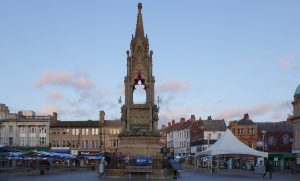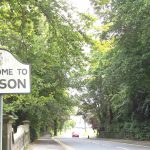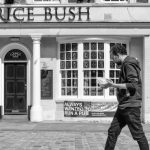Mansfield The Epitome of a Nottinghamshire Market Town.

Mansfield is a market town with a history that extends back to Roman settlement times. It lies on the route between Sheffield and Sherwood Forest, in an area of international acclaim. It is an interesting town and initially, we wanted to find out about the towns Roman roots – wasn’t it mostly forest back then?
Let’s find out the Five Minutes Spare way… This time our story starts around 40 AD…
Early History of Mansfield
Mansfield was once called Mamesfelde, to the point where this is how it is recorded in early history. It quite literally means the field on the River Maun. It has become a popular second name in some areas. In very early Britain those who had no second names would name their families after towns or areas. If you are of the Mansfield family then you are probably descended from old English roots.
The earliest settlement of Mansfield would have been around Roman times when a villa is said to have been erected. The remains of this villa were discovered in the 18th century and a stash of Roman coins was later found in the same area. Back in those days you would bury your treasure instead of banking it. Especially if you wanted to hide it from your enemies or invading parties – like the Vikings.
In Roman times the town fell under the territories of the Cortani and would have been in the province of Flavia Caesariensis. The discovered villa is recorded and even drawn out in great detail (here) but has been lost to time and the farmer’s plough since. A terrible shame. Evidence doesn’t suggest the presence of a fort, though, so the potential single villa may have been a summer residence for a noteworthy Roman.
For the next nearly a thousand years, not much mention is made of Mansfield. We do know, however, that Sherwood Forest was an important Viking site. Among the same trees that Robin Hood would call home hundreds of years afterwards, the Vikings held meetings and used the forest as a sort of court space. Disputes would be settled, cases pled and fights witnessed – all in the forest. This likely happened because of its central location to Nottinghamshire[i].
The Viking site of honour in Sherwood is called Thynghowe. Here, a circle would have been held to pass judgement on another Norsemen. Although Mansfield might never have held a Viking fort town, it still contributed to the Viking world.
Domesday – Not the End of the World
By the time of the Domesday Survey, Mansfield had grown enough to become mentioned, at least. Under the entry of Mamesfelde, it is recorded as having a notable population of 20.7 households. We are not sure what the .7 is all about. Maybe it had twenty households and one beggar.
The lands of Mansfield belonged to the King in 1086… that’s the Norman King who had invaded ten years before… King William. This means it probably belonged to Saxon nobles before this. At any rate, the land contained two leagues of woodland, 24 acres of fields, 1 mill, 1 fishery and two churches. This is so sizable it is in the top 40% of all settlements recorded. The previous owner is marked only as King Edward.
They also had 35 villagers, 5 freemen, 20 smallholders, 2 priests (a sign of astonishing wealth) and 19.5 ploughmen. Again… we’re not sure where the .5 ploughmen came from and we really don’t want to speculate. If you want to read the entry yourself you can visit the Open Domesday Archives.
Sometime in the 1100s, a Royal lodging was built in Clipstone, a nearby settlement. Known as King John’s Palace, this area was used as a retreat by royals and nobles right up until the 15th century. Throughout this period, those same royals might be spotted around Nottinghamshire, perhaps even visiting the noble families of Mansfield… so much information has been lost to time.
In 1227 the town was granted its first actual market charter. This meant that previous markets were technically illegal. The charter was granted by King Henry III and allowed ‘the men of Maunesfield’ to have a Monday market. In 1377 this charter was extended by Richard II to allow a four day fair, to commence two days after the Feast of the Blessed Peter and Paul. It is also recorded that the Parish church of St. Peter was damaged in a fire[ii].
In 1475 the Church gained an extra two Chantry chapels. Unfortunately, through most of the middle ages, the Churches were the only folk that thought to write anything down. While this is brilliant for posterity – there is a lot of church detail and not much else.
The next entry into the history books comes in 1546 when 130 houses were burned to the ground. A woman was caught, tried, and hanged in nearby Nottingham… Still, in 1581 another 150 houses were burned down by accident at Stockwell gate. As an interesting note, the town set up a commission to evaluate Sherwood forest. It had nothing to do with Robin Hood. Back then, there were 480 oaks around the town that had existed for more than two hundred years…
The following century saw the sale of King John’s Palace to the Earl of Newcastle and the founding of an alms-houses to help the poor in town. Let’s take a moment to talk about some of the fun facts to come out of Mansfield before we go any further.
Fun Facts about Mansfield
Loads of awesome things have happened in this area throughout the years. Here are some of the Five Minutes Spare favourites!
- Mansfield is the recorded centre of Sherwood Forest – probably because of that first commission arranged away back in the 1500s. The centre of the forest is in West Gate.
- Mansfield city council like to boast that the town centre is a better rated shopping centre than Covent Gardens, in London. We can’t testify to this, but we can laugh at their arrogance. Read more about when the BBC got involved…
- DH Lawrence wrote about the town in Lady Chatterley’s Lover. He described how it used to be a romantic town before the collieries took over.
- Mansfield Railway Station is on the aptly-named Robin Hood line, and the whole town has a Robin Hood connection.
- Speaking of which the town had no railway service from 12 October 1964 – 10 November 1995. This was due to the Beeching purge, which for reasons known only to the man himself deemed Mansfielddidn’t need a station. There were over 400,000 rail journeys from the town in 2019!
As you can see, there is no shortage of fun to be had in a town once mistakenly described as the worst place in Britain. We simply don’t agree. We do think, however, that before the Industrial age there might have been a little less concrete to the place.
Mansfield’s Great Expansion
Like many sleepy English towns, the Industrial Revolution hit hard and fast. The streets swelled to accommodate the new residents. The main industries grew based upon coal mining, but soon came to incorporate red and white sandstone quarrying, some of which was used to build Westminster! Mansfield grew so much during the revolution that it became Nottinghamshire’s second largest town… impressive.
1731 saw the opening of a Charity School which led to education for even the poorest children. In 1702 the Old Meeting House in West Gate was opened. 1776 saw the addition of a bridge following rioting over pay. A trade meeting was interrupted, the papers were seized, and the peasantry carried them through the streets! From this point forward workers were paid their dues.
It was in 1786 that two separate Roman Villas were discovered – although they have been lost to the years. A second charity school was opened, and a reverend opened a learning retreat at Cromwell house… which isn’t as weird as it sounds. The industrial revolution in Mansfield started, it seemed, with education.
In the 1800s there was further rioting regarding the cost of bread, but it didn’t last long. The masses took their rage out on the baker houses. Around this time the population had grown to nearly 7,000 people… so presumably their riots were vicious.
1819 saw the arrival of the railway into and out of town. IT transported coal dug from nearby mines out to steelworks around Nottinghamshire. The gas works were built in 1824 and were shortly afterwards used for street lighting… a trend that would continue until electricity replaced gas lamps at the start of the following century.
1836 saw the addition of a town hall and the introduction of a Poor Law Union, who were meant to look out for the poor and avoid future riots… A clock was placed on the town hall the following year and new union workhouses were built. The people of Mansfield were dragging themselves out of the gutters, piece by piece.
After this things really sped up. A bank was added, public baths were opened, and a brewery sprang up. The cemetery was extended, and St. John’s Church opened. Old Dial’s Yard was built from an old public house in 1841, the White Hart Inn was founded in ’73, and the population passed 8k. The fifteen-arch railway viaduct, the jewel of the town, was completed in 1875 and a cattle market was added two years later. In 1891 the population was 15,925 people. In one hundred years it had more than doubled… and all thanks to that railway.
Let’s pause again, this time to talk about famous people out of Mansfield… are there any? Let’s find out!
Famous People from Mansfield
Some of the most widely recognised public figures to be born in Mansfield include:
- The collective Cantamus Girls Choir, famed for winning the World Choir Olympic gold medal, in consecutive events (2004 & 2006) practice in Mansfield.
- Sticking with Music we have English rock singer and stage actor Alvin Stardust, although not born there did spend a big chunk of his childhood here.
- Swimmer Rebecca Adlington, the double gold medal winner at the 2008 Olympic games, was born and trains in Mansfield.
- Former Scotland International Kris Commons, who also played football with Celtic F.C., is from the town, although he never played for the local side.
- The cricketer Richard Hodgkinson was also born here… we are beginning to think there are some excellent sports facilities in Mansfield.
- Let’s not forget former Gadget Geeks presenter Tom Scott, a comedian born here too.
Mansfield brings celebrities from all walks of life to the table.
The 20th Century
So Mansfield rocketed into the twentieth century with some 15 thousand in population, only to steadily grow from there. It grew so much, in fact, that 130 graves were removed from outside St Peter’s church in 1905… to make room for road expansions. A new library opened around the same time. We do not know where the bodies were moved to. We would be wary of taking on a job in the library though, just in case.
The same year saw a tram service introduced. Five years later the Palace Theatre was opened, probably named after King John’s Palace, however loosely. By 1911 the population had more than doubled again, this time to 36k. By 1929 allegedly the town residents didn’t trust electricity over coal power, so a showroom was opened in West Gate to show off the wonders of electricity. This was a fairly unusual occurrence in Britain around that time. The trams were replaced by buses in the same era.
Sadly, in the 1940s, the centre of Sherwood forest in West Gate had to be chopped down. A sad day for the town. By the ’60s the railway station had been closed down and the census read 57,638 residents. A new library was opened in ’77, the bus station was built, and in 1995 that railway station was finally put back into use[iii].
Today, Mansfield has gone through the reputation wringer. Traditionally known as a concrete jungle, we were pleased to discover that there are some wonderful things to do in Mansfield, even if there is a lot of stone… after all, Sherwood forest is right there on the doorstep. How many trees to do you need?
Things to see and do in Mansfield
So let’s cut forward twenty years. What sort of things can you see and do in Mansfield if you are here on holiday? We asked the locals to find out.
Historic Sites and Attractions
From anywhere in town you should be able to pick out the industrial chimney at the Pleasley Colliery. Run by the Pleasley Pit Trust, this place is a museum where you can learn all about coal excavation in the Industrial Age. It’s a little unsettling when you learn that young boys would be sent down the darkest shafts… but it’s always nice to remind your kids what they would have been doing had they been born two hundred years ago…
Scare ‘em straight, that’s what we say.
Asides from the colliery, you will find an afternoon’s historical amusement at the Mansfield Museum. They regularly celebrate the past and present of their lovely town. Their main attraction? They have all sorts of exhibits aimed specifically at kids. Bring them for a visit as one of the top afternoons out with kids in Mansfield.
Of course, the oldest building in town is the St. Peter and St. Paul’s Church building – with all of its many additions throughout the years. If you are in the least bit religious, it makes for an interesting sight to see.
Outdoors and Recreation
Well… do we need to mention that wonderful forest again? Sherwood is littered with activity centres and camping grounds so you can go mad. While you are there we recommend that you stop by the Sherwood Forest Visitor Centre if you need any information or have any questions. They are very helpful. In terms of the forest, Sherwood Pines Forest Park is the most popular area.
If you like your parks to include more swing-sets and fewer trees try Titchfield Park, which is picnic territory. They have outdoor courts that are available to rent out if you want a game of five-a-side or the likes.
There are two more recreation places we would check out if we had kids. The Sherwood Forest Fun Park is designed as a play/amusement park. It’s a big play centre and you can let them run riot. The Water Meadows Leisure Centre is where the locals go swimming.
Museums and Galleries
We already covered some of the museums in town, but we missed one out. The Mansfield Fire Museum is one of those places you take the young ones to teach them about fire engines. All kids love fire engines… you’re onto a winner.
There’s also plenty of art in town. Check out the Calvie Gallery for a good cross-section of local and historical works. They have a pretty eclectic mix that you could spend a whole week getting to know. Thirdly, check out Triptyque art on the main street. They have a museum, galleries, and stuff for kids… but they sell those really inky pens everyone loves.
Shopping and Retail
As we previously mentioned – the council are very, very proud of the town centre and there is great shopping to be had in Mansfield. You should also check out Edwinstowe High Street for some quaint little places to shop if you are heading out to visit the nearby village. The place is popular as a tourist attraction as it is gorgeous.
Other Notable Mansfield Attractions
There are so many things to do in Mansfield that we couldn’t fit them all into one place – at least, not with the detail we would like to add in. Some of the other things to do in Mansfield that you really ought to make time for, include:
- Robin Hood and Maid Marian – the statues! Find them in Edwinstowe, just ten minutes away.
- Playmania – if you want to let the little ones burn off some energy then check in to Playmania for a bit.
- Drop in and take a tour of the stadium or catch a Mansfield Town
So there is plenty to do in this town, whether you are there on your own, with friends, or with the family.
Where to Eat, Drink, and Party in Mansfield?
If you are staying in town you are going to need some entertainment of a more pressing nature. Food, for one thing. If you happen to be looking for somewhere to wine and dine a client or potential partner, book in at Ciao Bella on Nottingham Road. Bella Italia is slightly better if you love Italian but want to eat with the family.
Looking for nightlife? Students favour both the Foxglove and the Jug and Glass. The Brown Cow is a great place to grab a decent pint and the Brass Monkey reputedly has the best cocktails. Between these, you have a pretty good night out.
As for clubs, The Oddfellow’s isn’t a bad choice but you will have to make the trip out to Sutton in Ashfield and book a cab back. Rush is open late and has DJ’s most weekends, so is one of the best places to dance the night away. You should keep an eye on who is guesting the DJ booth if you are familiar to the scene.
How to get there
Now you know all that we do – except how to get there. We got you, don’t worry.
By Road
From the South Head north out of London on the M1 and turn east at Sutton in Ashfield. From the North head for Penrith and follow the A1(M) all the way down.
By Rail
Mansfield sits on the Robin Hood Line which runs between Worksop & Nottingham and both have connections to the wider rail network. Make sure you choose Mansfield Railway Station as it is the most central, while Mansfield Woodhouse railway station is actually in a nearby village, about 1.2 miles North.
By Air
The nearest airport to Mansfield is the East Midlands Airport which is located at Castle Donington in Leicestershire. It’s about 27 miles away on the M1 and by far the easiest way to complete the journey. You could use public transport but that would involve travelling to Nottingham first.
By Sea
Alas, the town is land-locked. The River Maun might be sailable, though if you were really determined.
Got Five Minutes?
If you enjoyed our guide to Mansfield but still find you need entertainment – you can get more, for free, right now! Head on over to the Five Minutes Spare headquarters and find out all there is to know about your town!
[i] https://nottstv.com/ancient-viking-meeting-point-sherwood-forest-discovered-archaeologists/
[ii] www.visitoruk.com/Mansfield/14th-century-T4182.html
https://patgodonline.blogspot.com/2010/08/fascinating-facts-about-mansfield.html
[iii] www.visitoruk.com/Mansfield/20th-century-T2982.html



